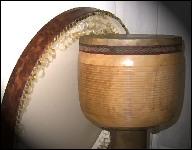Tonbak and Daf, the Two National Drums of Iran

Tonbak is the Persian goblet drum and chief drum of Persian music. Goblet-shaped drums are played in different regions of Asia, East Europe and North Africa. Though there are some similarities among all goblet drums, but the techniques for playing the tonbak is very different from the other goblet drums of the world. The finger patterns and techniques of the only goblet drum that is very similar to the tonbak is zirbaghali (the Afghani goblet drum).
The structure of tonbak is considered to have five parts: Skin, Body, Throat, Small Opening and Large Opening. Skin of Tonbak is glued on the head of Tonbak. Goatskin is most popular. Body of Tonbak is wooden. This is in fact the sound box of Tonbak. Sometimes many furrows are carved on its wood. Throat is almost cylindrical and it is connected from top to the body. Tonbak is open from the top and bottom. Small opening is in the bottom. It is similar to the mouth of trumpet. In fact throat and small opening together are in the form of a trumpet. Large opening is in the top and the skin is covered on it.
Daf is the Persian frame drum. There are many similar frame drums in all over the world. The structure of daf is divided into six parts as follows: Frame is wooden. The diameter of the frame is 48-53 centimeters. The width of the frame is 5-7 centimeters. Skin is glued on the frame. The most popular is goatskin. Pins are applied in behind part of the frame in order to keep the skin on the frame tightly. Hooks are applied in order to hang the rings in the inner part of frame. Rings are the jingles of daf. Leather band is applied in order to help the player for long duration performances.
Tonbak and daf are considered as pre-Islamic drums of Persia, since there are some pre-Islamic books mentioning to the names of these drums. The Pahlavi (Persian language spoken during pre-Islamic ages) name of the tonbak is dombalag. And etymologists believe that the name tonbak and similar names such as tombak, donbak and dombak and so on have been all derived from this Pahlavi name. It is so interesting that even today the word dumbelek is used for the Turkish goblet drum. I wonder if there is any relationship between the tonbak and gedombak, the Malay goblet drum. The Pahlavi name of daf is dap and it is believed that daf is the Arabicized name of dap. The name daf with its different dialects used in some other areas is not the aim of this article to be discussed here. Only one point that the name dap even today is used in Uyghuristan (a part of today China).
Unfortunately the history of Persian musical instruments is in dispute. The history of Persian music shows that many books have been written on Persian music and it is unfortunate that many of them have not survived and many of them that have survived have not been published in Iran.
According to my personal research, there are no books for describing Persian drums, though in many books many names of Persian drums have been mentioned. What we know is that tonbak and daf were played in the past, but how, I have not found any info!
Anyway, my friend, Mr. Mehdi Moghiceh (painter) and I found two Persian paintings belonging to 16th century, showing some gypsy tonbak, daf and dohol (Persian cylindrical drum) players. Also recently I found a poem of the very famous poet, Amir Khosro Dehlavi, mentioning to tonbak-e-hindi that should be a kind of Indian goblet drum, maybe related to Kashmiri goblet drum, tumbaknari.
Today, Tonbak is played in different genres of Persian music: It is played in Persian art music genre. Thanks to many books written on the tonbak recently, we know much about the tonbak and tonbak players from ghajar period up to present. Also it is played in motrebi style. Motrebi music is that genre of music that is played in some festive occasions such as wedding ceremonies, though today unfortunately this style of tonbak playing is going to be forgotten. It is played in regional (folk) music of Persia, particularly the regions of Lorestan, Kurdistan and Hormozgan too. Another kind of tonbak, called tonbak-e-zourkhaneh, that its size is larger than ordinary tonbak, is played in zourkhaneh, Persian traditional gymnasium.
Fortunately there are more paintings showing people playing frame drums. Daf, in the works of many poets such as Hafiz, Rumi have been mentioned and it has been the chief instrument of many Sufi gatherings. Even today daf is played in khangah (temple of Sufis).
What is important here is to mention that daf was considered a spiritual frame drum to be played in Sufi gatherings. Thanks to many daf players, recently daf has been promoted in Iran very much. This instrument that was considered only a Sufi drum to be played khangah (temple of Sufis), now it is played in many other Persian music genres successfully so that it is considered the second national drum of Iran beside the tonbak

